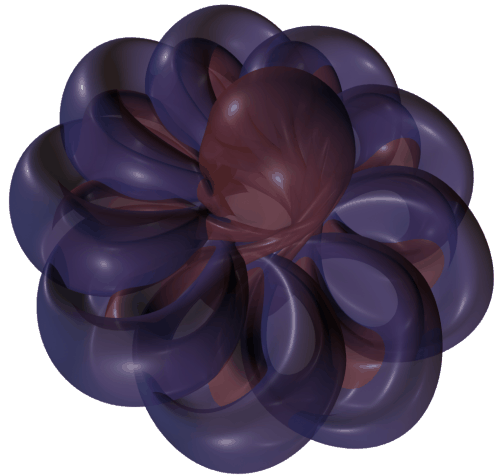
Organized by Steve Ferry (sferry@math.rutgers.edu), Feng Luo (fluo@math.rutgers.edu), Saul Schleimer (saulsch@math.rutgers.edu) and Chris Woodward (ctw@math.rutgers.edu)
Tuesday, January 25. Reserved for special talk.
Tuesday, February 1. Reserved for special talk.
Wednesday, February 2. Katrin Wehrheim, SPECIAL PLACE: Hill 705. Special Time: 11:30.
Tuesday, February 8. Penny Smith, Lehigh. Tiitle: Viscosity methods for Symmetric Hyperbolic Systems and the Einstein Cauchy Problem.
Tuesday, February 15. Andras Stipsicz, IAS.
Title: Exotic smooth structures on rational surfaces
Abstract: Most known smoothable simply connected 4--manifolds admit infinitely many different smooth structures (distinguished, for example, by Seiberg--Witten invariants). There are some 4--manifolds, though, for which the existence of such 'exotic' structures is still open, the most notable examples being the 4--dimensional sphere S^4 and the complex projective plane CP^2. In a recent project with Z. Szabo and J. Park we found constructions of exotic smooth structures on the five- and six-fold blow--up of CP^2. In the lecture we describe the construction of these 4--manifolds and indicate the necessary input from Seiberg--Witten theory for proving their exoticness.
Tuesday, February 22. No seminar. (But see Friday's colloquium.)
Tuesday, March 1. No talk.
Tuesday, March 8. No talk.
Tuesday, March 15. Spring Break.
Tuesday, March 22. Double-header:
2:45 Megumi Harada, University of Toronto.
Title: Kirwan surjectivity for K-theory
Abstract: Let (M, omega) be a Hamiltonian G-space with a proper moment map. We give a surjectivity result which expresses the K-theory of the symplectic quotient M//G in terms of the K-theory of the original manifold M, under certain technical conditions on the moment map. This result is the natural K-theoretic analogue of the Kirwan surjectivity theorem in symplectic geometry. Along the way, we prove a K-theoretic version of a key lemma of Atiyah and Bott, which states that the equivariant K-theory Euler class of a G-bundle is not a zero divisor, provided that an S^1 subgroup fixes precisely the zero seciton. This is a key result in equivariant symplectic geometry, and we hope that it will have many applications towards proving K-theoretic versions of well-known equivariant cohomological results in Hamiltonian geometry.
4:00 Gordana Matic, University of Georgia, Athens.
Title: "Right veering diffeomorphisms of surfaces and contact topology"
Tuesday, March 29. 3pm Jane Gilman, Rutgers Newark. Title: Classical T-Schottky Groups
Abstract: We find algebraic equations that describe the boundary of the parameter space for the classical T-Schottky space of a Kleinian group generated by two parabolic elements. The groups we consider correspond to doubly cusped manifolds with at least two double cusps or equivalently a noded Riemann surface of genus two with at least two distinct nodes. We also give a description of the boundary of the space of Kleinian groups that are NSDC groups, non-separating disjoint circle groups. Additionally, our results allow us to explicitly construct the groups in a one complex parameter family of non-classical T-Schottky groups and to identify these groups in the Riley slice of Schottky space. The existence of non-classical Schottky groups was first shown by Marden. The only known explicit construction of such a group is due to Yamamoto.
Tuesday, April 5. Liat Kessler, NYU. Title: Torus actions on small blow ups of CP^2'.
Tuesday, April 12. Johan Martens, Columbia.
Title: Instanton Counting and Non-Abelian Localization
Abstract: Nekrasov has shown how the low-energy behaviour of certain super-symmetric quantum field theories can be derived from calculating equivariant volumes of moduli-spaces of instantons. From a mathematical point of view this work generates a number of remarkable geometric conjectures. We review this and related recent work, and then sketch an alternative method in symplectic geometry for calculating the equivariant volumes, using varying compactifications of the ADHM spaces and the Jeffrey-Kirwan-Witten method of non-abelian localization. The advantage of this method is that it does not require smoothness of the moduli-spaces, and is therefore very suited for calculations on the moduli-spaces for classical gauge groups other then SU(n).
Tuesday, April 19. Greg Landweber, Oregon.
"Twisted representation rings and Dirac Induction"
Using ideas of twisted equivariant K-theory, we construct twisted versions of the representation rings for Lie superalgebras and Lie supergroups, built from projective Z_2-graded representations with a given cocycle. We then investigate the pullback and pushforward maps on these representation rings associated to homomorphisms of Lie superalgebras and Lie supergroups.
As an application, given a compact Lie group G, we construct a Lie supergroup by taking the cotangent bundle T*G and reversing the parity of its fibers. An inclusion of Lie groups H --> G induces a pushforward homomorphism between the twisted representation rings of the corresponding Lie supergroups T*H and T*G, which pulls back via a Thom isomorphism to give an additive homomorphism from R(H) --> R(G). We then show that this homomorphism is in fact Dirac induction, which takes an H-module $U$ to the G-equivariant index of the Dirac operator on the homogeneous space G/H with values in the homogeneous bundle induced by U.
Friday, April 22. Dan Margalit, Utah. 2pm, Hill 425.
Title: Finiteness properties of the Torelli subgroup of Out(F_3)
Abstract: Let K_n be the kernel of the natural map from Out(F_n) to GL(n,Z). This group was studied by Nielsen (1918) and Magnus (1934), who showed that K_n is finitely generated. We give a simple topological approach to the theorem of Krstic and McCool (1997) that K_3 is not finitely presented. Further, we show that the second homology of K_3 is not finitely generated and that K_3 a 2-dimensional K(K_3,1). With an eye towards understanding this group in higher rank, we approach the problem from a Morse theoretic point of view. This is work in progress with Mladen Bestvina and Kai-Uwe Bux.